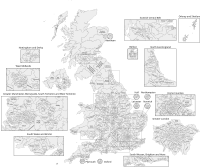Loading AI tools
Electoral divisions of the parliament of the United Kingdom From Wikipedia, the free encyclopedia
The Parliament of the United Kingdom currently has 650 parliamentary constituencies across the constituent countries (England, Scotland, Wales, and Northern Ireland), each electing a single member of parliament (MP) to the House of Commons by the plurality (first past the post) voting system, ordinarily every five years. Voting last took place in all 650 of those constituencies at the United Kingdom general election on 4 July 2024.
| United Kingdom parliamentary constituencies | |
|---|---|
 Constituencies after the 2023 Periodic Review | |
| Category | Electoral district |
| Location | United Kingdom |
| Number | 650 (as of 2023) |
| Government | |
The number of seats rose from 646 to 650 at the 2010 general election after proposals made by the boundary commissions for England, Wales, and Northern Ireland (the Fifth Periodic Review of Westminster constituencies) were adopted through statutory instruments.[1][2][3][4] Constituencies in Scotland remained unchanged, as the Boundary Commission for Scotland had completed a review just before the 2005 general election, which had resulted in a reduction of 13 seats.
Primary legislation provides for the independence of the boundary commissions for each of the four parts of the UK, the number of seats for each of the countries, permissible factors to use in departing from any old boundaries, and a strong duty to consult. The Fifth Review was governed by the Parliamentary Constituencies Act of 1986. Under the Parliamentary Voting System and Constituencies Act 2011, as amended by the Parliamentary Constituencies Act 2020, the number of MPs is now fixed at 650. The Sainte-Laguë formula method is used to form groups of seats split between the four parts of the United Kingdom and the English regions (as defined by the NUTS 1 statistical regions of England).[5]
The table below gives the number of eligible voters broken down by constituent country, including the average constituency size in each country.
| Year | 2000 | 2010 | 2015 | 2017[6] | 2019[7] | |||||
|---|---|---|---|---|---|---|---|---|---|---|
| Numbers | % | Numbers | % | Numbers | % | Numbers | % | Numbers | % | |
| Total electorate for each constituent country | ||||||||||
| England | 36,994,681 | 83.47% | 38,432,802 | 83.81% | 38,736,146 | 83.57% | 38,693,900 | 83.85% | 39,901,035 | 83.88% |
| Scotland | 3,995,489 | 9.02% | 3,929,956 | 8.57% | 4,099,532 | 8.84% | 3,950,600 | 8.56% | 4,053,056 | 8.52% |
| Wales | 2,225,689 | 5.02% | 2,302,300 | 5.02% | 2,281,754 | 4.92% | 2,261,200 | 4.90% | 2,319,690 | 4.88% |
| Northern Ireland | 1,103,670 | 2.49% | 1,190,635 | 2.60% | 1,236,765 | 2.67% | 1,242,300 | 2.69% | 1,293,971 | 2.72% |
| UK total | 44,319,529 | — | 45,855,693 | — | 46,354,197 | — | 46,148,000 | — | 47,567,752 | — |
| Average electorate per constituency for each constituent country | ||||||||||
| England | 69,408 | 101.80% | 72,107 | 102.21% | 72,676 | 101.91% | 72,596 | 102.25% | 74,861 | 102.30% |
| Scotland | 67,720 | 99.32% | 66,609 | 94.42% | 69,484 | 97.43% | 66,959 | 94.31% | 68,696 | 93.87% |
| Wales | 55,642 | 81.61% | 57,558 | 81.59% | 57,044 | 79.99% | 56,530 | 79.62% | 57,992 | 79.24% |
| Northern Ireland | 61,315 | 89.93% | 66,146 | 93.76% | 68,709 | 96.35% | 69,017 | 97.21% | 71,887 | 98.23% |
| Overall UK average | 68,184 | — | 70,547 | — | 71,314 | — | 70,997 | — | 73,181 | — |
As of 2023, every recommended constituency must have an electorate as at 2 March 2020 that is no smaller than 69,724 and no larger than 77,062.[8] The exceptions to this rule are five 'protected' constituencies for island areas: Orkney and Shetland, Na h-Eileanan an Iar, Ynys Mon, and two constituencies on the Isle of Wight.[9] These consequently have smaller electorates than the lower limit for other constituencies.
As the number of electors in each constituency is similar, the constituencies themselves vary considerably in area, ranging in 2019 from Ross, Skye and Lochaber, which occupies a sixth of Scotland, to the densely-populated London constituency of Islington North.
| Largest | Smallest | |
|---|---|---|
| England | Penrith and The Border 3,135 square kilometres (1,210 sq mi) | Islington North 7.38 square kilometres (2.85 sq mi) |
| Scotland | Ross, Skye and Lochaber 12,768 square kilometres (4,930 sq mi) | Glasgow North 16.86 square kilometres (6.51 sq mi) |
| Wales | Brecon and Radnorshire 3,015 square kilometres (1,164 sq mi) | Cardiff Central 16.83 square kilometres (6.50 sq mi) |
| Northern Ireland | Fermanagh and South Tyrone 2,512 square kilometres (970 sq mi) | Belfast North 50.34 square kilometres (19.44 sq mi) |

As of the 2024 election there are 543 constituencies in England, 32 in Wales, 57 in Scotland and 18 in Northern Ireland.
The "Region" of the table refers to the NUTS 1 statistical region of England, which coincides with the former European Parliament constituency in which the constituency was included until 31 January 2020.
Following the abandonment of the Sixth Periodic Review (the 2018 review), the Boundary Commissions formally launched the 2023 Review on 5 January 2021 and published their final proposals on 28 June 2023.[15]
See 2023 Periodic Review of Westminster constituencies and List of United Kingdom Parliament constituencies (2024–present) by region for further details.
Seamless Wikipedia browsing. On steroids.
Every time you click a link to Wikipedia, Wiktionary or Wikiquote in your browser's search results, it will show the modern Wikiwand interface.
Wikiwand extension is a five stars, simple, with minimum permission required to keep your browsing private, safe and transparent.